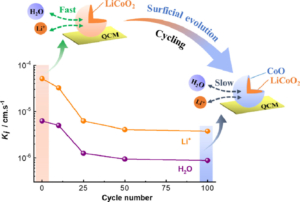Interface evolution and performance degradation in LiCoO2 composite battery electrodes monitored by advanced EQCM
Authors: Wanli Gao, Christel Laberty-Robert, Natacha Krins, Catherine Debiemme-Chouvya, Hubert Perrot and Ozlem Sel.
Journal: Electrochimica Acta (2022)
Abstract
Unravelling the underlying reasons for degradation mechanism of battery materials is of great fundamental and practical importance. For a classical electrode consisting of an active material, a conductive additive, and a polymeric binder, its capacity fading is commonly related with (i) mechanical degradation of polymeric binder and/or (ii) structural and compositional degradation of active materials. The former is more relevant for electrodes showing volume expansion and represented by the progressive breakage of polymeric binder network during battery operation, leading to the dissolution of the other two components into electrolytes. The latter is generally reflected by an irreversible phase transition in active materials, which may affect the species exchanged at the electrode/electrolyte interface and their interfacial transfer dynamics. By employing a coupled methodology pairing electrochemical techniques with piezoelectric probes derived from quartz crystal microbalance (QCM), this work reports on the evolution of the interfacial processes during electrochemical cycling and correlates to the performance degradation of the electrodes. Shown on a LiCoO2 (LCO) composite electrode as a model system, it was revealed that bare Li+ without a hydration sheath plays a dominant role in charge balance irrespective of the aging degree of the electrode under the experimental conditions of this work. However, Li+ transfer is closely accompanied with free H2O molecules with a Li+:H2O ratio around 10:1 at a polarization state close to LCO redox potential (0.65 V vs. Ag/AgCl). This ratio persists in all cycled electrodes with gradually faded interfacial transfer kinetics of Li+ and H2O along cycling. Such a fading in species interfacial transfer kinetics driven by the surficial evolution from LiCoO2 to CoO plays a major role in the electrode performance degradation during cycling.

You may read the full paper here.
Interface evolution and performance degradation in LiCoO2 composite battery electrodes monitored by advanced EQCM











